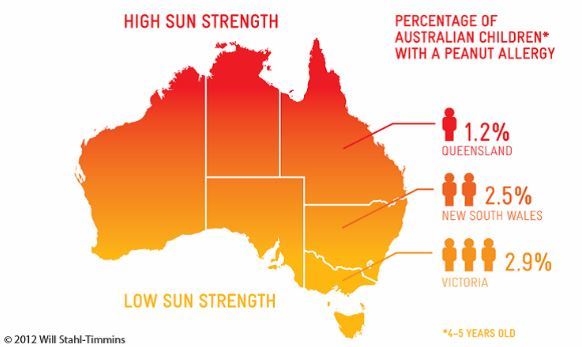Childhood Food Allergies (UK 1 in 14) – huge recent increase (low vitamin D)
Why the world is becoming more allergic to food
BBC Dec 2018
“Food allergy now affects about 7% of children in the UK and 9% of those in Australia, for example.”
“For example, there was a five-fold increase in peanut allergies in the UK between 1995 and 2016.”
“One study found 9% of Australian one-year-olds had an egg allergy, while 3% were allergic to peanuts.”
“Migrants appear to show a higher prevalence of asthma and food allergy in their adopted country compared to their country of origin, further illustrating the importance of environmental factors.”
- Note: Migrants often have dark skin and thus lower levels of vitamin D
“Another idea is that vitamin D can help our immune system develop a healthy response, making us less susceptible to allergies. Most populations around the world do not get enough vitamin D for several reasons, including spending less time in the sun. In the US, the rate of vitamin D deficiency is thought to have almost doubled in just over a decade.”
See also Vitamin D Life
Vitamin D less than 15 ng associated with some allergies – Feb 2011
30 to 40 ng of vitamin D associated with the least peanut allergy – Nov 2012
Food allergy 12X more likely if low vitamin D and vitamin D binding gene problem – Aug 2015
Less sun (less vitamin D) more anaphylaxis (severe allergic reaction) – June 2014
Incidence of 22 health problems related to vitamin D have doubled in a decade
3 to 55 X more likely to have 63 health problems if low Vitamin D
3X more allergy to peanuts if child born with low UV – Feb 2011
- Vitamin D levels have been crashing since 1995 (Polish Children, US Military, etc

Items in both categories Autoimmune and Infant/Child are listed here:
{category}
Additional possible causes for reduced immunity (especially in developed countries)
Antibiotics and Vitamin D are associated with many of the same diseases
Increased screen time and decreased time outdoors, getting vitamin D if outdoors in middle of the day
Vaccinated children had more chronic diseases - Sept 2018
- {FONT(size="16")}Researchers polled the parents of over 650 homeschooled children, aged either 6 or 12
||Chronic Illness Diagnosis |% Vaccinated|% Unvaccinated
Children Diagnosed Allergic Rhinitis |10.4%| 0.4%
Other allergies| 22.2%|6.9%|| {FONT}
Childhood Food allergies increased 4.8 X recently to 1 in 4.5
Chicago Biomedical Consortium Sept 2018
$4,184 = Annual cost to manage one child’s food allergy


